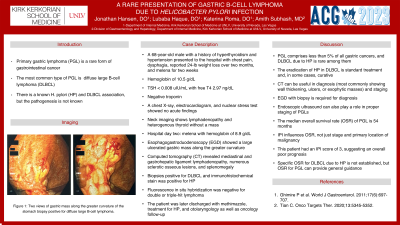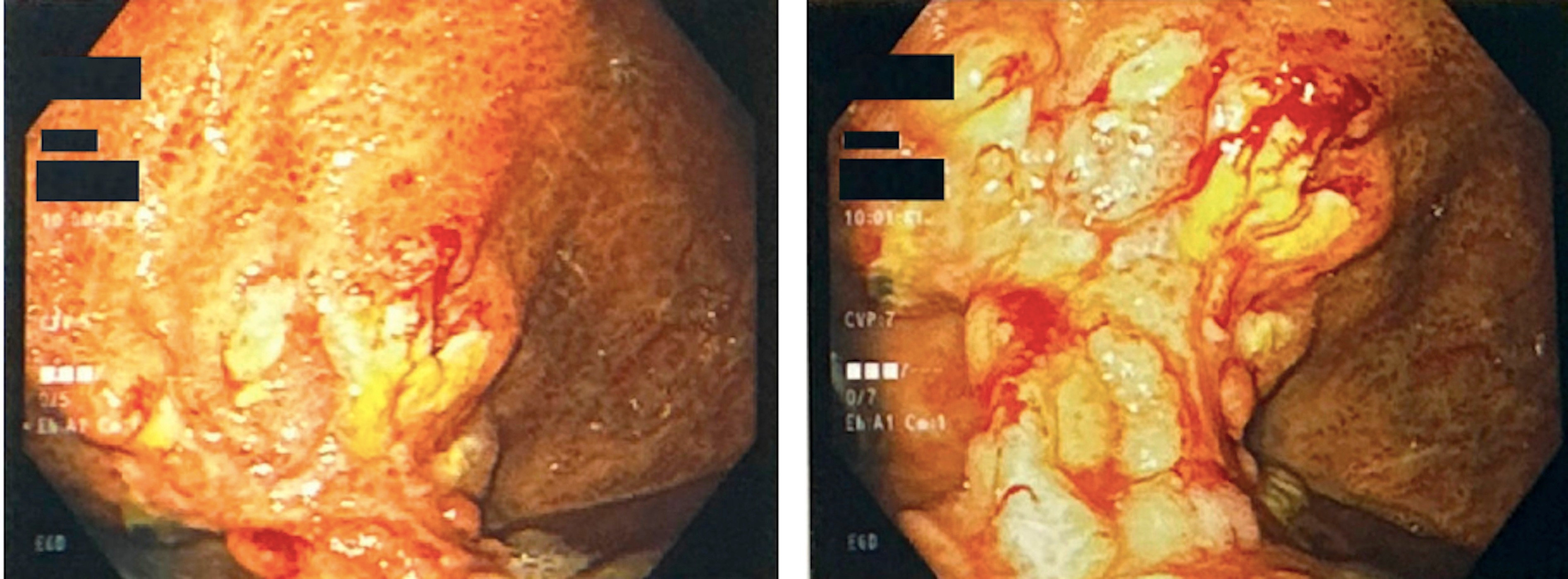Sunday Poster Session
Category: Stomach
P1369 - A Rare Presentation of Gastric B-Cell Lymphoma Due to Helicobacter pylori Infection
Sunday, October 22, 2023
3:30 PM - 7:00 PM PT
Location: Exhibit Hall

Has Audio

Jonathan Hansen, DO
Kirk Kerkorian School of Medicine at UNLV
Las Vegas, NV
Presenting Author(s)
Jonathan Hansen, DO, Lubaba Haque, DO, Katerina Roma, DO, Amith Subhash, MD
Kirk Kerkorian School of Medicine at UNLV, Las Vegas, NV
Introduction: Primary gastric lymphoma (PGL) is a rare form of gastrointestinal cancer1. The most common type of PGL is B-cell subtype diffuse large B-cell lymphoma (DLBCL)1. An association between H. pylori (HP) and DLBCL, while rare, is known, but the pathogenesis is unclear1. We present a case of DLBCL due to a HP infection.
Case Description/Methods: A 68-year-old male with a history of hyperthyroidism and hypertension presented to the hospital with chest pain, dysphagia, reported 24-lb weight loss over 2-months, and melena for 2 weeks. Laboratory results were significant for a hemoglobin of 10.5 g/dL , TSH < 0.008 uIU/mL, free T4 2.97 ng/dL, and negative troponin. A chest X-ray, electrocardiogram, and nuclear stress test showed no acute findings. Neck imaging found lymphadenopathy and a heterogenous thyroid without a mass. On hospital day 2, the patient had witnessed melena with a drop in hemoglobin to 8.9 g/dL. Esophagogastroduodenoscopy (EGD) was then performed and showed a large ulcerated gastric mass along the greater curvature that was subsequently biopsied. Computed tomography (CT) revealed mediastinal and gastrohepatic ligament lymphadenopathy, numerous sclerotic osseous lesions, and splenomegaly. Biopsies showed DLBCL and immunohistochemical stain was positive for HP. Fluorescence in situ hybridization was negative for double or triple-hit lymphoma. The patient was later discharged with methimazole, treatment for HP, and otolaryngology as well as oncology follow-up.
Discussion: PGL comprises less than 5% of all gastric cancers, and DLBCL due to HP is rare among them1. While a link between HP and some PGLs is established, the pathogenesis of HP causing DLBCL is unclear1. The eradication of HP in DLBCL is one of the mainstays of treatment and, in some cases, curative1. CT can be useful in diagnosis (most commonly showing wall thickening, ulcers, or exophytic masses) and staging. However, EGD with biopsy is required for diagnosis. Endoscopic ultrasound can also play a role in proper staging of PGLs.
The median overall survival rate (OSR) of PGL is 54 months2. Tian et al. showed stage and primary location of malignancy alone does not influence OSR, but International Prognostic Index (IPI) does2. For our patient, an IPI score of 3 was calculated suggesting an overall poor prognosis. Specific OSR for DLBCL due to HP is not established, but OSR for PGL can provide general guidance.
References:

Disclosures:
Jonathan Hansen, DO, Lubaba Haque, DO, Katerina Roma, DO, Amith Subhash, MD. P1369 - A Rare Presentation of Gastric B-Cell Lymphoma Due to Helicobacter pylori Infection, ACG 2023 Annual Scientific Meeting Abstracts. Vancouver, BC, Canada: American College of Gastroenterology.
Kirk Kerkorian School of Medicine at UNLV, Las Vegas, NV
Introduction: Primary gastric lymphoma (PGL) is a rare form of gastrointestinal cancer1. The most common type of PGL is B-cell subtype diffuse large B-cell lymphoma (DLBCL)1. An association between H. pylori (HP) and DLBCL, while rare, is known, but the pathogenesis is unclear1. We present a case of DLBCL due to a HP infection.
Case Description/Methods: A 68-year-old male with a history of hyperthyroidism and hypertension presented to the hospital with chest pain, dysphagia, reported 24-lb weight loss over 2-months, and melena for 2 weeks. Laboratory results were significant for a hemoglobin of 10.5 g/dL , TSH < 0.008 uIU/mL, free T4 2.97 ng/dL, and negative troponin. A chest X-ray, electrocardiogram, and nuclear stress test showed no acute findings. Neck imaging found lymphadenopathy and a heterogenous thyroid without a mass. On hospital day 2, the patient had witnessed melena with a drop in hemoglobin to 8.9 g/dL. Esophagogastroduodenoscopy (EGD) was then performed and showed a large ulcerated gastric mass along the greater curvature that was subsequently biopsied. Computed tomography (CT) revealed mediastinal and gastrohepatic ligament lymphadenopathy, numerous sclerotic osseous lesions, and splenomegaly. Biopsies showed DLBCL and immunohistochemical stain was positive for HP. Fluorescence in situ hybridization was negative for double or triple-hit lymphoma. The patient was later discharged with methimazole, treatment for HP, and otolaryngology as well as oncology follow-up.
Discussion: PGL comprises less than 5% of all gastric cancers, and DLBCL due to HP is rare among them1. While a link between HP and some PGLs is established, the pathogenesis of HP causing DLBCL is unclear1. The eradication of HP in DLBCL is one of the mainstays of treatment and, in some cases, curative1. CT can be useful in diagnosis (most commonly showing wall thickening, ulcers, or exophytic masses) and staging. However, EGD with biopsy is required for diagnosis. Endoscopic ultrasound can also play a role in proper staging of PGLs.
The median overall survival rate (OSR) of PGL is 54 months2. Tian et al. showed stage and primary location of malignancy alone does not influence OSR, but International Prognostic Index (IPI) does2. For our patient, an IPI score of 3 was calculated suggesting an overall poor prognosis. Specific OSR for DLBCL due to HP is not established, but OSR for PGL can provide general guidance.
References:
- Ghimire P et al.World J Gastroenterol. 2011;17(6):697-707.
- Tian C. Onco Targets Ther. 2020;13:5345-5352.

Figure: Figure 1. 2 views of the biopsy positive for diffuse large B-cell lymphoma gastric mass along the greater curvature of the stomach.
Disclosures:
Jonathan Hansen indicated no relevant financial relationships.
Lubaba Haque indicated no relevant financial relationships.
Katerina Roma indicated no relevant financial relationships.
Amith Subhash indicated no relevant financial relationships.
Jonathan Hansen, DO, Lubaba Haque, DO, Katerina Roma, DO, Amith Subhash, MD. P1369 - A Rare Presentation of Gastric B-Cell Lymphoma Due to Helicobacter pylori Infection, ACG 2023 Annual Scientific Meeting Abstracts. Vancouver, BC, Canada: American College of Gastroenterology.
